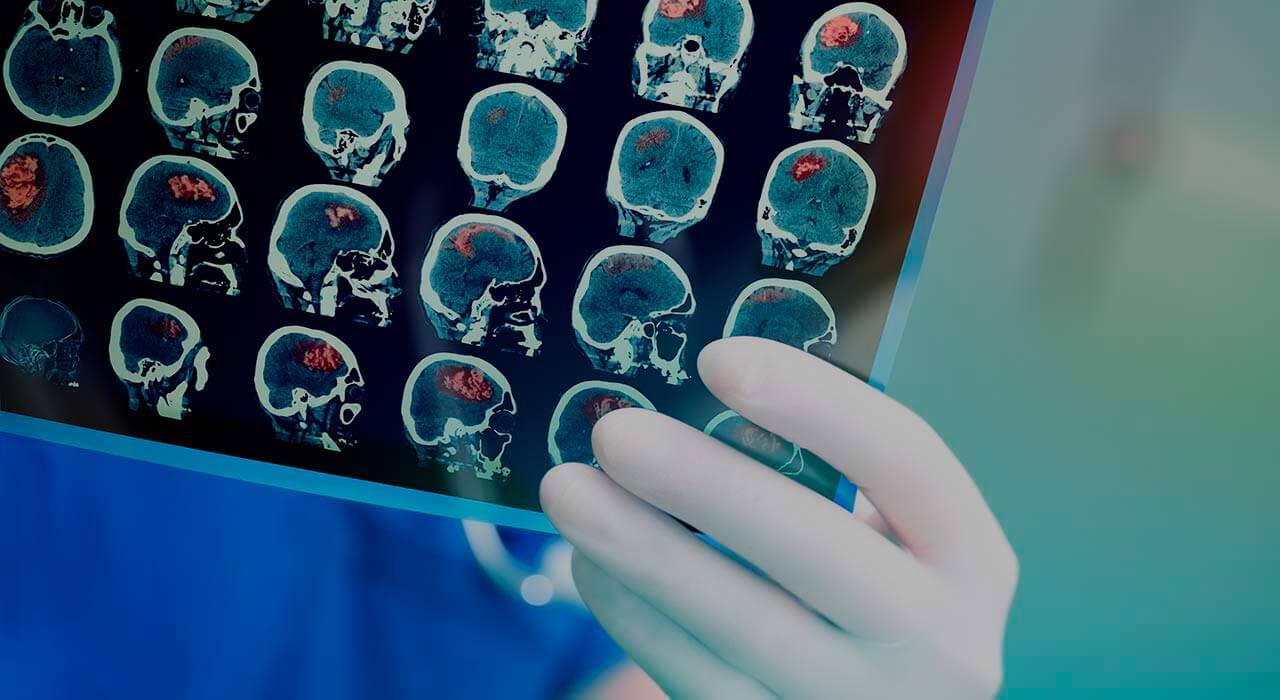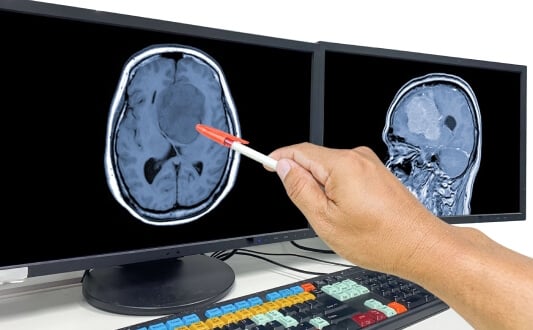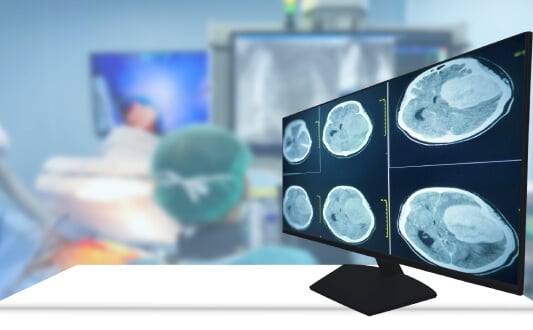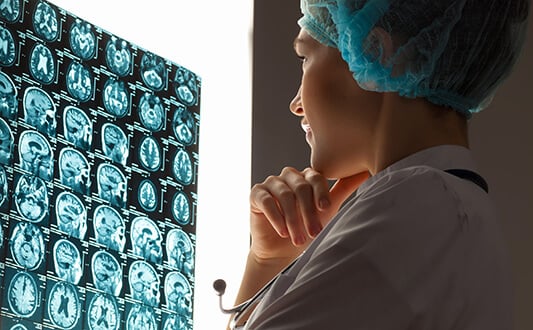The attitude of patients and healthcare professionals to benign brain tumors is rather contradictory. On one hand, such tumors are not connected to the oncological process – they grow slowly or even remain the same size, do not invade nearby tissues and organs, and stay at the site of origin without metastasizing.
A benign tumor is the most favorable tumor type, which may cause no symptoms and need nothing more, but active surveillance. On the other hand, even the tiniest tumors near vital centers of the brain cause certain harm in case of growing. Even non-malignant neoplasm inside the skull is a potential cause of neurological problems.
In such a situation, healthcare professionals should make the most beneficial for the patient decision, as brain surgery always has certain risks. Paying close attention to possible symptoms of benign brain tumors is very helpful in early diagnosis and successful treatment.
Content
- Is a benign brain tumor still a tumor?
- What causes benign brain tumors?
- Are all benign brain tumors the same?
- Are benign brain tumors dangerous, and why?
- Successful treatment of benign brain tumors abroad
Is a benign brain tumor still a tumor?
The word “tumor” is always frightening, as the terms “tumor” and “cancer” are strongly related in our minds. Nevertheless, the difference between them is essential. A tumor, in general, is a group of cells that have the same origin but multiply and grow without control. Under normal circumstances, all cells fulfill their functions, grow to a certain volume and die or divide into two new cells. Multiplying cells interrupt the normal structure of the tissue and form a mass or tumor visible on CT/MRI scan. Due to certain reasons, tumor cells don`t respond to physiological regulatory mechanisms.
A specific feature of all benign brain tumors is the total absence of abnormal, oncological characteristics during the histological examination. So, under the microscope, cells of benign tumors are similar to healthy tissue ones. Benign tumor cells can be somewhat bigger, but this is not an obligatory or threatening sign.
Beyond all doubt, performing an aspiration biopsy or examining of totally removed tumor is the most informative way to establish its origin, as sometimes malignant tumors can imitate benign ones. Unfortunately, these options are not always possible in brain tumors because of the certain risk of brain damage. Sometimes the tumor location is inconvenient (e.g., deep, behind bones, near the essential blood vessels or vital centers), so the possible risks of performing the biopsy outweigh presumable benefits.
In such cases, doctors (usually neurosurgeons and neurologists) take a close look at other distinctive features of benign tumors:
- Benign tumors usually grow slowly. Once revealed on the CT/MRI scan (this may happen even by accident), benign tumors remain stable with time (the most favorable variant) or grow by a few millimeters per year. Actually, due to the low speed of growth, benign tumors often cause no symptoms and can be revealed during the examination for other concomitant conditions.
- Benign tumors do not invade surrounding tissues. Such tumors can mechanically compress nearby brain tissue and vessels, but they are always structurally separated from them. When we look at the CT/MRI scan, the border between a tumor edge and surrounding tissue is always distinct and clear. Some tumors have an additional surrounding layer – tumor capsule, consisting of connective tissue.
- Benign tumors do not spread to other parts of the body. One of the trickiest moments in tumor treatment is detecting metastases – remote tumor loci, spread with the blood or lymphatic fluid from the maternal tumor. Benign tumors never metastasize; they are present only at the site of origin.
- Benign tumors can cause certain symptoms, and we will discuss the most important of them further, but general signs of oncological intoxication and cachexia (exhaustion) are not typical for them. Due to slow growth, benign tumors don`t require excessive essential nutrients and don`t steal them from normal tissues and organs. Also, benign tumors are stable and don`t tend to cause massive destruction. This means that they don`t release a huge amount of toxic degradation products in the blood flow, which is usual for malignant tumors.
What causes benign brain tumors?
Although benign brain tumors are more widespread than malignant ones, their causes still need to be specified.
Based on the information from clinical practice and some clinical trials, we should note the following risk factors:
- Age. The older you are, the higher the risk of developing a benign brain tumor is.
- Race. In general, brain tumors are more widespread among Caucasians compared to Europeans.
- Pathology and traumas during the pregnancy (cause inherited benign brain tumors).
- Family history of brain tumors. Some types of tumors are connected with genetic conditions – for example, Turcot syndrome, neurofibromatosis, and tuberous sclerosis.
- Radiation exposure. This Involves both treatments with ionizing radiation and accidental exposition during work or emergencies.
- Exposure to certain chemicals (e.g., vinyl chloride, formaldehyde). In case you work with dangerous substances, you should always use personal protective equipment.
Another widely discussed topic is the presence of a connection between brain tumor development and mobile phone usage. Indeed, cell phones release radiofrequency energy (radio waves), which is one of the non-ionizing radiation forms. This energy easily penetrates the skin and reaches nearby tissues and organs. When we have a phone conversation, the brain is the closest to the source of radiofrequency energy organs. If a person spends a long time over the phone, the strength of such impact increases.
Few clinical trials and reviews were performed to investigate this issue in greater detail, as mobile phones are really ubiquitous nowadays. As a result, National Institute of Health (NIH) studies have shown an absence of association between cell phone use and the incidence of benign brain tumors. This information was further confirmed by other healthcare organizations and institutions. The U.S. Food and Drug Administration (FDA) also made a statement on the safety of cell phone use for public health.
Are all benign brain tumors the same?
Virtually every cell of the brain can serve as the origin of tumor formation. Nevertheless, some cells, like neurons, are less likely to form a tumor as they don`t divide. Other cells, like cells of blood vessels or the pituitary gland, are more physiologically active and thus can be the structural basis of a tumor.
The type of the cell determines the localization of the tumor, speed of its growth, and ability to produce an excessive amount of the hormones.
The most important types of benign brain tumors are described below.
- Meningioma. This benign brain tumor is rather widespread and accounts for almost 20% of all brain tumors. It arises not from the nervous tissue directly but from the meninges – the three membranes (namely, the dura mater, the arachnoid mater, and the pia mater) that cover the brain and spinal cord to feed them and protect them from injuries. Thus meningiomas usually grow on the surface of the brain without invading deeper tissues. This type of tumor can potentially become quite large and reach 2-5 cm in size. We have already mentioned genetic risk factors of benign tumor development, and meningiomas are exactly from the group of such tumors – they are associated with neurofibromatosis type 2.
- Schwannoma or acoustic neuroma takes second place in terms of incidence rate and accounts for about 9% of all brain tumors. This tumor originates from the 8th cranial nerve (the vestibulocochlear nerve, which includes balance and hearing nerves), namely from its Schwann cells. Schwann cells form the outer layer of the nerve, produce myelin, and help in supporting and insulating nerve tissue. Schwannomas usually don`t change the location and don`t spread along the nerve. As the tumor grows, it starts affecting hearing and balance; tumors of greater size influence facial sensitivity and movements. The good news is schwannomas grow slowly or even remain stable in size. This tumor is also associated with neurofibromatosis type 2 and has a certain correlation with age – it mainly affects people between the ages of 30 and 60.
- Pituitary adenoma arises in a pituitary gland. The incidence rate of this tumor is almost similar to schwannoma`s one and accounts for about 8% of brain tumors. Nevertheless, pituitary adenoma is the most frequently revealed tumor, as it can be hormone-producing and cause a great variety of complaints and clinical signs. There are two main types of pituitary adenomas – pituitary microadenomas, which are less than 10 mm in size, and pituitary macroadenomas, which are greater than 10 mm in size. About 65% of all pituitary adenomas produce hormones; usually, these are microadenomas. The most common microadenoma product is prolactin. Other possible variants include growth hormone (GH), adrenocorticotropin (ACTH), and thyrotropin (TSH). Macroadenomas are hormonally inactive but can affect nearby tissues due to their greater size. There can be tumors with mixed hormones secretion, as well.
- Hemangioblastoma takes origin in blood vessels of the brain. As a vital part of the body, the brain requires an excellent supply of oxygen and nutrients, so its blood flow is rich and intensive. Nevertheless, brain vessels are usually protected by inner mechanisms, and the incidence rate of this benign tumor type reaches only 2% of all brain tumors. It is quite obvious that hemangioblastomas also grow outside the brain tissue, but they can press on the brain once they are large enough. Sometimes the tumor is not solid but has a form of a cyst or a closed sac mass. The development of hemangioblastomas is associated with von Hippel-Lindau (VHL) syndrome, which is an inherited condition. However, they can also arise sporadically in totally healthy people.
- Craniopharyngioma is more often found in children but can also affect adults. The incidence rate of this tumor accounts for about 1%-3% of all brain tumors. It arises from the cell remnants of Rathke's pouch (nasopharynx) and is connected with abnormal fetus development during the pregnancy. Craniopharyngioma is usually a cystic tumor. It is called “a tumor with benign cellular structure and malignant behavior,” as it has a certain tendency to an invasion of surrounding structures and recurs after the resection. Craniopharyngiomas are usually located near two important endocrine glands – the pituitary gland and the hypothalamus – and can directly influence hormone levels when they are large enough. Craniopharyngioma treatment can be performed at any age, depending on the patient's general state and clinical indications.
- Choroid plexus papilloma is more typical for children and accounts for less than 1% of brain tumors. The choroid plexus is a bunch of brain vessels that surround the ventricles and produce cerebrospinal fluid (CSF). Active proliferation of cells in this region leads to solid vascular tumor formation and thus – to interruption of cerebrospinal fluid flow. Choroid plexus papilloma grows slowly, as all benign brain tumors do, but in the most complicated cases, it can block the flow of the CSF completely. This tumor type also has a certain genetic background – in certain cases, it is connected with a mutation in the TP53 gene.
- Epidermoid and dermoid cysts (tumors) are actually uncommon lesions. These “tumors” are not solid structures but hollow cysts (sometimes filled with fluid). Most healthcare professionals consider them to be a kind of benign tumor due to their intracranial (inside the skull) location and possible influence on brain tissue.
In addition, healthcare specialists estimate all tumors according to the unified grading scale of WHO (World Health Organization). This scale gives marks from 1 to 4 according to the tumor`s speed of growth, risk of metastasizing, and probability of recurrence after the treatment. Non-cancerous (benign) tumors of the brain are always classed as grade “1” or “2” because they grow slowly, don`t spread to other parts of a body, and are unlikely to grow back after treatment completion.
Are benign brain tumors dangerous, and why?
Benign brain tumors are not dangerous themselves, as they do not invade surrounding tissues or metastasize, do not deprive healthy tissues of nutrients, remain stable and do not cause intoxication with their degradation products, do not harm blood vessels, and cause bleedings, etc. Small benign tumors are often asymptomatic and can be revealed only by accident.
Nevertheless, in certain circumstances, benign tumors influence the general state of a person, cause symptoms, and can even be life-threatening.
The main mechanisms of harmful influence are the following:
- Pressure on the surrounding tissues, including vital centers. As already mentioned, benign tumors are clearly separated from surrounding tissues and sometimes even have an additional capsule. At the same time, each neoplasm causes certain pressure on the nearby structures. Even slight influence can be significant if we are talking about vital centers, e.g., the respiratory center or motor center, because brain tissue is highly specialized.
- Increasing general volume of the brain. The bones of the human skull are connected tightly, so it has a strictly limited volume. The size of a healthy brain with its tunics and blood vessels fits this volume perfectly. Each benign tumor has a certain volume, which is added to the general one. At first compensatory mechanisms smooth this difference, but it becomes impossible when a tumor grows. Compression of the brain leads to its swelling and additional damage. In such cases, neurological symptoms, including seizures, arise almost immediately.
- Blocking cerebrospinal fluid flow. This mechanism is specific for choroid plexus papilloma, especially at a young age. The tumor can produce an excessive amount of cerebrospinal fluid and increase pressure inside the system. Another possible problem is the direct blocking of the fluid flow when a tumor grows directly into the lumen of the spinal canal. In such cases, the process can also disturb the state and functions of the spinal cord.
Benign brain tumors can cause a bunch of general (which occur in many other diseases) and certain symptoms. This mainly depends on the localization and size of the tumor.
We can think about benign brain tumors in the presence of such signs as;
- Severe recurrent headaches that worsen in the morning and do not respond to usual painkillers. Headache can also occur during night's sleep and becomes more intensive during physical exercise, coughing, or sneezing.
- Vomiting without connection to objective causes (e.g., poisoning, intoxications, gastrointestinal problems, pregnancy). Vomiting can be preceded by nausea, but not always. It is not connected with diet or quantity of food and can arise even on an empty stomach.
- A gradual, partial loss of hearing can be a sign of schwannoma, as this tumor involves the hearing nerve. Compression of the nerve fibers disturbs its function up to the total deafness.
- Poor coordination is another sign of schwannoma. Unsteadiness and loss of balance arise in the affection of the balance nerve, a part of the vestibulocochlear nerve. Naturally, balance disturbances in benign brain tumors can`t be treated with usual antidinic drugs.
- A gradual, partial loss of vision arises in tumors of the occipital lobe, where the vision center is located. In such cases, the eyes and optic nerves may perfectly perceive all the information, but the brain is unable to process it.
- Changes in smells perception arise in olfactory (smell) brain affection. Smells perception can be distorted or totally absent in advanced tumors.
- Weakness in legs and arms and numbness, especially when it involves only one part of the body. These symptoms arise when large tumors put pressure on the motor or sensitive brain centers or cause changes in cerebrospinal fluid flow and thus affect the spinal cord.
- Seizures and losing consciousness are a consequence of changes in the brain's electrical activity. High cortical excitability causes seizures and syncopes.
- Changes in mental functions, e.g., memory (namely, short-term one), speech, comprehension, and attentiveness. Such changes are usually gradual but stable and don`t depend on the previous level of intellectual activity.
- Stable changes in personality – mood (depression and loss of energy), behavior, personal preferences. Undoubtedly, people can acquire new features during life, but sudden and unexplainable changes should draw attention.
Naturally, it is much better to detect and remove a tumor while it is “silent” (asymptomatic) and causes no harm to delicate brain tissue. Another important moment is precise diagnosis after revealing symptoms.
Successful treatment of benign brain tumors abroad
Benign brain tumors are perfectly detected with the help of visualizing techniques – X-ray examination, CT, and MRI of the brain. Naturally, such examinations are not included in the usual check-up programs. That is why the first step to the correct diagnosis and treatment is a doctor`s consultation. Usually, people start by attending a general practitioner, as benign brain tumor signs can also exist in many other diseases. A doctor's qualification, practical experience, and willingness to help are the cornerstones of solving this problem.
A doctor should be competent in a few spheres of medicine in order to make a careful differential diagnosis in the presence of numerous but not specific symptoms.
The next essential point is the availability of modern diagnostic equipment in healthcare institutions. We always need high-resolution CT / MRI to obtain reliable information about brain structure and tumor presence. Good quality images are the basis of planning aspiration biopsy – the next significant step in revealing the character of a tumor. In certain cases, performing a biopsy is impossible due to a tumor location. Revealing this doctor proceeds to treatment planning. In order to choose the best treatment option, a board of healthcare professionals discusses the clinical case and advises on the type of surgical intervention or radiotherapy.
It is quite obvious that only going through careful medical examination and being under the surveillance of the most competent doctors ensures a decent result of treatment. Nowadays, people often consider visiting foreign countries with greater medical potential for check-ups and consequent treatment. This is totally possible, as many countries are open to international patients, although it is connected with certain organizational difficulties and medical peculiarities. Some of the leading hospitals that accept foreign patients for the treatment of brain tumors are:
- University Hospital Muenster, Department of Neurosurgery
- Charite University Hospital Berlin, Department of Adult and Pediatric Neurosurgery
- University Hospital Freiburg, Department of Adult and Pediatric Neurosurgery
- University Hospital Frankfurt am Main, Department of Adult and Pediatric Neurosurgery
- University Hospital Erlangen, Department of Adult and Pediatric Neurosurgery
The most appropriate option for arranging treatment abroad is using the help of the company Booking Health. Booking Health is a medical tourism company that annually helps thousands of patients with brain tumors with examination and treatment abroad.
Booking Health offers help in such significant aspects as:
- Recommending the best doctor and clinic for your case
- Booking an appointment on the convenient date
- Organizing comprehensive examination, including the interventional one
- Providing you with the transfer, interpreter, and medical coordinator, if necessary
- Preparing for you all the medical reports and further recommendations
- Providing help in further surgical treatment, if necessary
- Providing help in further neurological rehabilitation, if necessary
- Providing help in further communication with your treating physician
To start planning your check-up or treatment, you should leave the request on the website of Booking Health. Our patient case manager or medical advisor will contact you the same day to discuss all the details of the check-up program or surgical intervention in case of a confirmed diagnosis. Our work aims to help you improve and maintain your health.
Choose treatment abroad and you will for sure get the best results!
Authors:
This article was edited by medical experts, board-certified doctors Dr. Nadezhda Ivanisova, and Dr. Bohdan Mykhalniuk. For the treatment of the conditions referred to in the article, you must consult a doctor; the information in the article is not intended for self-medication!
Our editorial policy, which details our commitment to accuracy and transparency, is available here. Click this link to review our policies.
Sources:
Centers for Disease Control and Prevention
Read:
Don't know where to start?
Contact Booking Health







